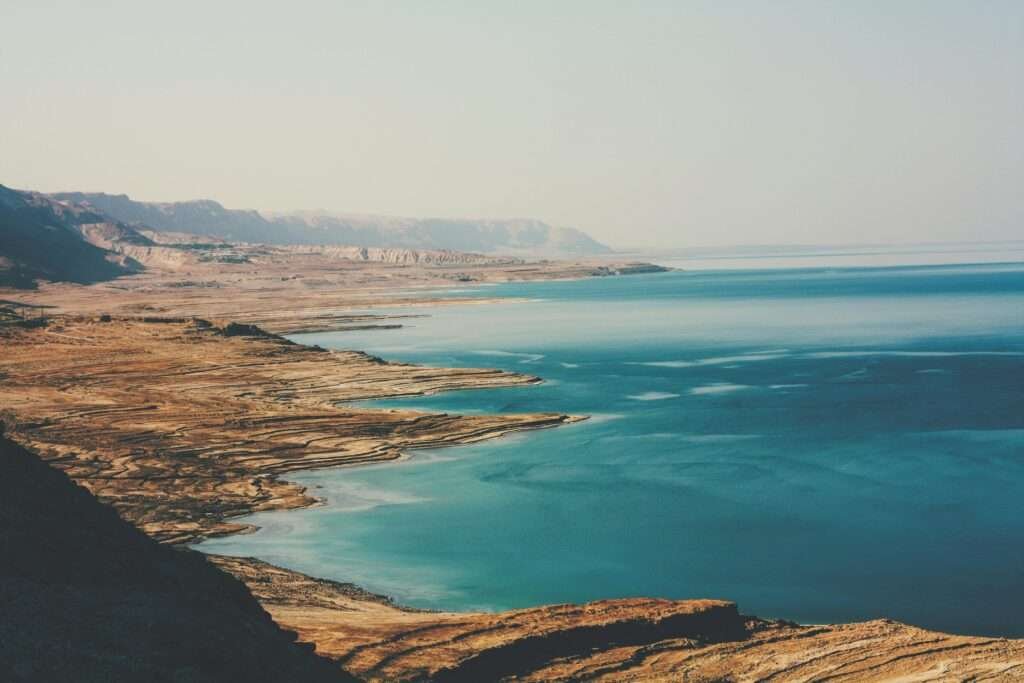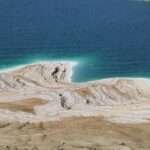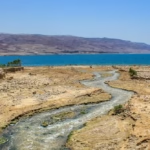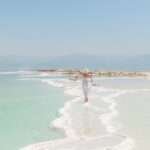The Dead Sea is a hypersaline, endorheic lake in the Jordan Rift Valley whose shores are the lowest point on land (about −1,444 ft/−440 m as of 2025). Its water is ~34% salt—around 10× ocean salinity—so people float easily. The lake has been shrinking by around 1 meter (3.3 ft) per year due to evaporation and reduced inflow.
A Quick Orientation to the Dead Sea
The Dead Sea (Arabic: al-Baḥr al-Mayyit; Hebrew: Yam ha-Melaḥ) lies within the Jordan Rift Valley, fed mainly by the Jordan River and smaller wadis, with no outflow to the ocean (an “endorheic” basin). The main, northern water body is about 31 miles (50 kilometers) long and up to 9 miles (15 kilometers) wide; the south has largely been transformed into industrial evaporation ponds.
As of 2025, the water surface sits roughly −1,444 feet (−440 meters) below sea level, making it the lowest land elevation on Earth. Salinity averages about 34% (roughly 342 g/kg), giving the brine a density ~1.24 kg/L—one reason you float like a cork. These numbers vary by season and depth but show why the Dead Sea is so distinctive among lakes.
Key Numbers at a Glance
Below are reference figures useful for travelers, students, and editors. Sources include NASA/USGS and standard references noted throughout this article.
| Metric | Value |
|---|---|
| Elevation (2025) | ≈ −1,444 ft (−440 m) below sea level |
| Max depth | ≈ 997 ft (≈304 m) |
| Salinity | ≈ 34% (≈342 g/kg) |
| Length × width (north basin) | ≈ 31 × 9 mi (≈50 × 15 km) |
| Area (2016 ref.) | ≈ 234 sq mi (≈605 km²) |
| Annual rainfall near shore | ≈ 2–2.5 in (≈50–65 mm) |
Data sources: NASA Earth Observatory; USGS Earthshots; Britannica climate notes.
How the Dead Sea Formed — The Rift at the Meeting of Plates
The Dead Sea sits within a tectonic scar known as the Dead Sea Transform (DST)—a strike-slip (transform) boundary where the African Plate (to the west) and the Arabian Plate (to the east) slide past each other. Over millions of years, this shearing motion opened elongated “pull-apart” basins that later filled with sediments and brines, creating the Jordan Rift Valley’s chain of depressions (Gulf of Aqaba, Dead Sea, Sea of Galilee).
Think of the DST as the Middle East’s cousin to California’s San Andreas Fault: a narrow zone of lateral motion and occasional earthquakes. The rift’s subsidence plus an arid climate produced the extreme low elevation we see today. Geologic studies indicate ~105 kilometers (65 miles) of cumulative left-lateral motion since the Miocene, enough to rearrange landscapes and river paths across the region.
A transform fault between Africa and Arabia
USGS mapping shows the DST as the dividing line of two plates, with spreading in the Red Sea to the south and complex deformation northward into Anatolia. This geologic setting explains the Dead Sea’s narrow valley, steep escarpments, and deep subsurface basins that collect salts and sediments.
Two basins, one shrinking lake
Historically, the Dead Sea comprised a deeper northern basin and a shallower southern basin. As water levels fell in recent decades, the southern basin separated and became a network of evaporation ponds for mineral extraction. This north–south shift matters for navigation, tourism, and environmental monitoring.
Chemistry & Buoyancy — Why You Float and What Makes the Brine Unique
The Dead Sea is one of the saltiest lakes on Earth. Its surface brine typically hovers around 30–34% dissolved salts—about ten times that of the ocean—and is so dense (~1.24 kg/L) that swimmers float with almost no effort. For comparison, Utah’s Great Salt Lake varies widely (roughly 5–27%), while Antarctica’s Don Juan Pond exceeds 40%.
Chemically, the Dead Sea is different from seawater. Instead of being dominated by sodium chloride, the brine is rich in magnesium and calcium chlorides with notable potassium and exceptionally high bromide. Classic analyses show anhydrous salts by weight of roughly ~51% MgCl₂, ~30% NaCl, ~14% CaCl₂, and ~4–5% KCl, though proportions vary with season and depth.
Salinity, density, and the “hard to sink” physics
Buoyancy follows Archimedes’ principle: denser water provides more upward force. With salinity near 34%, Dead Sea water feels almost oily and keeps you on the surface—why lifeguards often tell visitors to “sit back” rather than try to swim. NASA’s Earth Observatory has illustrated this vividly in multiple explainers. See NASA’s Dead Sea salinity explainer.
Mineral mix (Mg, Ca, K, Na, bromide) and spa claims
The brine’s unusual dominance of magnesium and calcium—plus the famous black mud—underpins a century of “climatotherapy.” While many cosmetics tout benefits, the strongest, peer-reviewed facts are about composition rather than medical cures: high MgCl₂, low sulfates, and record bromide. For raw composition snapshots, NASA/JPL and technical reviews remain informative reads.
Weather, air, and UV at the lowest land on Earth
Being far below sea level means thicker air and filtered UV compared with nearby highlands. Winters are mild (northern shore ~58°F/14°C; southern Sedom ~63°F/17°C) and rain is scarce—about 2–2.5 inches (50–65 mm) per year—while summers are hot and bone-dry.
Falling Water Levels, Sinkholes, and a Changing Shoreline
The Dead Sea is shrinking. Since the 1960s, diversions from the Jordan River and its headwaters, together with strong evaporation, have pushed the lake down roughly 1 meter (3.3 feet) per year on average, exposing broad salt flats and triggering ground instability. USGS analyses and Israeli monitoring show decades of retreat and a shoreline that has marched inward by kilometers in places.
Direct measurements place Dead Sea evaporation around ~1.1–1.2 meters per year (3.6–3.9 feet/year), depending on season and wind, while older budgets bracketed ~1.05–2.0 m/year. Less freshwater in, more water vapor out—that’s the core hydrologic equation.
What’s driving the drop?
Three drivers dominate: (1) Diversion of Jordan River flows for cities and farms (especially after Israel’s National Water Carrier, 1960s), (2) Industrial evaporation for mineral production in both Israel and Jordan, and (3) The region’s hot, arid climate fueling high evaporation. Together, these have reduced the lake’s surface by roughly a third since mid-century.
Sinkholes explained—and new “white smoker” clues
As the shoreline retreats, fresh groundwater dissolves buried salt layers, causing overlying soils to collapse into sinkholes. More than 5,500 have been mapped along Israel’s coast alone. In 2024, divers documented “white smoker” brine chimneys on the lake floor; clusters may flag zones prone to future sinkholes, offering an early-warning proxy for hazard mapping.
| Year (selected) | Approx. Level (m below sea level) | Context |
|---|---|---|
| 1896 | −389 m | A late-19th-century high point noted in historical records. |
| 1970 | ≈ −395 m | Precipitous modern decline begins after upstream diversions. |
| 2016 | ≈ −430.5 m | Reference year often cited with area ≈605 km². |
| 2018 | — | Decline rate peaked near 1.2 m/year in some analyses. |
| 2025 | ≈ −440 m | Still among the fastest-shrinking large lakes on Earth. |
Timelines, rates, and realistic futures
USGS scenario models show that without inflows, the lake could continue dropping steeply, while substantial restoration of Jordan River flows could slow or reverse the decline. In plain terms: the Dead Sea’s fate hinges on water management far upstream as much as local weather.
People, Industry, and Geopolitics Around the Dead Sea
The Dead Sea is not just a natural wonder; it’s a major mineral resource. On the Israeli side, ICL’s Dead Sea Works produces potash, bromine, and magnesium compounds using vast evaporation ponds; Jordan’s Arab Potash Company (APC) mirrors these operations to the southeast, and Jordan Bromine manufactures bromine derivatives. These industries supply fertilizers and specialty chemicals worldwide.
Capacities are large by any measure: ICL’s Dead Sea potash capacity was estimated at ~4.2 million tonnes/year in 2020, while APC reports ~2.5 million tonnes/year. Industrial footprints influence hydrology because each ton of product implies evaporating and moving enormous volumes of brine.
Borders, water-sharing, and the Red–Dead & “water-for-energy” ideas
The lake touches Jordan, Israel, and the Palestinian territories (West Bank), and sits downstream of the Jordan River system shared by multiple riparians. One proposed fix—the Red Sea–Dead Sea Conveyance to bring desalination brine north—stalled and was reported abandoned in 2021; more recently, Israel and Jordan explored a “water-for-energy” arrangement (Project Prosperity) exchanging solar power and desalinated water, though geopolitical shocks slowed momentum.
Civil society groups like EcoPeace Middle East argue for reviving the Lower Jordan River with treated wastewater and other sources, rather than pumping Red Sea brine, to stabilize the Dead Sea more naturally over time. See EcoPeace’s regional rehabilitation plan.
Visiting the Dead Sea (Israel & Jordan): Where to Go, When, and How to Do It Safely
Where to go. On the Jordanian side, the primary resort strip is at Sweimeh; on the Israeli side, popular public beaches and hotels cluster around Ein Bokek (with Masada and Ein Gedi nearby). From Amman to Sweimeh is roughly 34 miles (≈55 km) by road; from Jerusalem to Ein Bokek is roughly 66–76 miles (≈106–123 km) depending on route and endpoint.
When to go. Late autumn through spring (roughly October–April) brings milder temperatures; summers are extremely hot and very dry. Annual rainfall along the shore is only about 2–2.5 inches (≈50–65 mm), so always bring water, sun protection, and footwear for salt-encrusted shorelines.
How to float safely. Use regulated beaches with showers and lifeguards. Israel’s Ministry of Health posts an online map and advisories for bathing sites; heed closures. Don’t dive or submerge your face, and limit each soak to ~15–20 minutes before rinsing with fresh water. Check current bathing quality/advisories.
Getting there, distances, seasons
From Amman’s city center, resorts at Sweimeh are about a 50–60 minute drive (≈34 miles/≈55 km). From Jerusalem, direct buses run to Ein Bokek in about 1¾–2 hours; driving time is similar in light traffic. Shoulder seasons (Oct–Nov, Mar–Apr) offer the best mix of warmth and manageable midday heat.
Safety & etiquette: regulated beaches, don’ts, and health notes
Because of sinkholes, avoid unmarked coastlines. Enter slowly, sit back to float, avoid shaving/cuts before you go, keep water out of eyes and mouth, and rinse promptly. Follow local health advisories and lifeguard instructions; the high salinity that makes floating fun also demands caution. For general recreational-water standards, see the WHO guidance.
Dead Sea vs. Other Hypersaline Lakes (quick comparison)
Globally, the Dead Sea is near the top of the salinity charts but not the absolute record-holder. Don Juan Pond in Antarctica can exceed 40% salt; Lake Assal (Djibouti) and some Caspian lagoons also edge higher at times. What sets the Dead Sea apart is scale, accessibility, and its dramatic setting at Earth’s lowest land elevation.
Compared with Utah’s Great Salt Lake, the Dead Sea is consistently saltier and far deeper (≈304 m/997 ft). Great Salt Lake’s salinity swings widely with inflows and evaporation, while the Dead Sea’s enclosed basin and mineral-industry evaporation keep salinity stably extreme. NASA’s explainers give an excellent visual sense of these contrasts.
FAQ
Is the Dead Sea really the lowest place on Earth?
Yes—on land. As of 2025 its shore sits around −1,444 ft (−440 m). The number changes slightly with seasonal level changes, but the Dead Sea remains the lowest exposed land elevation globally.
Why is it called the “Dead” Sea—does anything live in it?
Its salt content is too high for fish or aquatic plants, but specialized microbes (like halophilic bacteria and algae during rare fresher pulses) can occur. A famous 1980 bloom followed unusually rainy conditions.
How dangerous are sinkholes for visitors?
Sinkholes cluster along retreating shorelines where fresh groundwater dissolves subsurface salt. Use regulated beaches and marked parking; heed local signage. Scientists are even testing “white smoker” chimney clusters on the lake floor as potential early-warning indicators.
Can large projects refill or “save” the Dead Sea?
A proposed Red Sea–Dead Sea brine conveyance was reported abandoned in 2021. Newer ideas (e.g., water-for-energy exchanges) exist, but robust Jordan River restoration and regional cooperation are widely seen as crucial to slowing the decline.
What Did We Learn Today?
- The Dead Sea is a hypersaline, endorheic lake at ≈ −1,444 ft (−440 m)—Earth’s lowest land point.
- Salinity averages ~34%—about 10× the ocean—so you naturally float.
- Levels have dropped about 1 m (3.3 ft) per year in recent decades from diversions and evaporation.
- Sinkholes arise as fresh groundwater dissolves subsurface salt; new “white smoker” chimneys may help map risk.
- Industry (potash, bromine) and geopolitics shape management options; cooperation on Jordan River flows remains pivotal.





